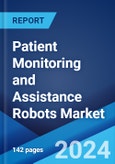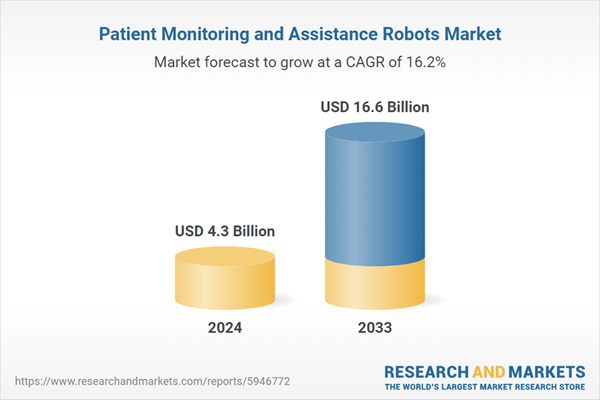The global patient monitoring and assistance robots market size reached USD 4.3 Billion in 2024. Looking forward, the publisher expects the market to reach USD 16.6 Billion by 2033, exhibiting a growth rate (CAGR) of 15.34% during 2025-2033. The rising geriatric population, significant growth in the healthcare industry, the integration of advanced technologies to achieve better monitoring accuracy and enhance communication capabilities, and extensive research and development (R&D) activities, represent some of the key factors driving the market.
Patient monitoring and assistance robots are advanced technological systems designed to assist healthcare professionals in monitoring patients and providing assistance with tasks. These robots are equipped with various sensors, cameras, and communication capabilities. They are widely used to monitor vital signs such as heart rate, blood pressure, and oxygen levels and provide physical assistance to patients with limited mobility or disabilities. Patient monitoring and assistance robots help to improve patient safety, increase efficiency, and collect and analyze large amounts of data. They also assist in enhancing patient care, improving healthcare outcomes, and alleviating the workload on healthcare professionals. As a result, these robots find extensive applications across hospitals, clinics, and medical centers.
Patient monitoring and assistance robots are advanced technological systems designed to assist healthcare professionals in monitoring patients and providing assistance with tasks. These robots are equipped with various sensors, cameras, and communication capabilities. They are widely used to monitor vital signs such as heart rate, blood pressure, and oxygen levels and provide physical assistance to patients with limited mobility or disabilities. Patient monitoring and assistance robots help to improve patient safety, increase efficiency, and collect and analyze large amounts of data. They also assist in enhancing patient care, improving healthcare outcomes, and alleviating the workload on healthcare professionals. As a result, these robots find extensive applications across hospitals, clinics, and medical centers.
Patient Monitoring and Assistance Robots Market Trends:
The rising geriatric population and increasing incidences of chronic disease are among the key factors propelling the market growth. Patient monitoring and assistance robots are widely used to monitor patients' vital signs and health conditions remotely, reducing the need for frequent hospital visits and enabling early detection of health issues. In line with this, the widespread adoption of robots to monitor and assist patients during surgeries, medical examinations, and rehabilitation sessions is favoring the market growth. Moreover, the increasing demand for patient monitoring and assistance robots to help reduce healthcare costs by minimizing hospital readmissions, preventing falls and injuries, and improving medication adherence is creating a positive outlook for the market. Besides this, the integration of improved sensors and artificial intelligence (AI) and machine learning (ML) algorithms to enable better monitoring accuracy and enhance communication capabilities is providing an impetus to the market growth. Additionally, the introduction of advanced robots with improved mobility and navigation systems to maneuver in hospital settings, navigate obstacles, and reach patients efficiently, reducing response times and enhancing their overall functionality, is contributing to the market growth. Furthermore, the widespread adoption of handicap assistance robots that help patients suffering from vision or hearing impairments and physical disabilities with daily activities, such as eating food, and drinking water, is positively influencing the market growth. Other factors, including a rising emphasis on patient safety and quality of care, significant growth in the healthcare industry, rapid technological advancements, the implementation of various government initiatives to improve healthcare technology, and extensive research and development (R&D) activities, are presenting remunerative growth opportunities for the market.Key Market Segmentation:
The publisher provides an analysis of the key trends in each segment of the global patient monitoring and assistance robots market, along with forecasts at the global, regional, and country levels from 2025-2033. Our report has categorized the market based on type and application.Type Insights:
- Handicap Assistance Robots
- Autonomous Mobile Transport Robots
- Daily Care Robots
- Telepresence Robots
Application Insights:
- Hospitals
- Clinics
- Medical Centers
- Others
Regional Insights:
- North America
- United States
- Canada
- Asia Pacific
- China
- Japan
- India
- South Korea
- Australia
- Indonesia
- Others
- Europe
- Germany
- France
- United Kingdom
- Italy
- Spain
- Russia
- Others
- Latin America
- Brazil
- Mexico
- Others
- Middle East and Africa
Competitive Landscape:
The report has also provided a comprehensive analysis of the competitive landscape in the global patient monitoring and assistance robots market. Detailed profiles of all major companies have been provided. Some of the companies covered include Awabot, Kinova Inc., KUKA AG (Midea Group), Panasonic Holdings Corporation, ST Engineering Aethon Inc. (Singapore Technologies Engineering Ltd), The Lamson Group, Vecna Technologies, etc. Kindly note that this only represents a partial list of companies, and the complete list has been provided in the report.Key Questions Answered in This Report:
- How has the global patient monitoring and assistance robots market performed so far, and how will it perform in the coming years?
- What are the drivers, restraints, and opportunities in the global patient monitoring and assistance robots market?
- What is the impact of each driver, restraint, and opportunity on the global patient monitoring and assistance robots market?
- What are the key regional markets?
- Which countries represent the most attractive patient monitoring and assistance robots market?
- What is the breakup of the market based on the type?
- Which is the most attractive type in the patient monitoring and assistance robots market?
- What is the breakup of the market based on the application?
- Which is the most attractive application in the patient monitoring and assistance robots market?
- What is the competitive structure of the global patient monitoring and assistance robots market?
- Who are the key players/companies in the global patient monitoring and assistance robots market?
Table of Contents
1 Preface3 Executive Summary10 Value Chain Analysis12 Price Analysis
2 Scope and Methodology
4 Introduction
5 Global Patient Monitoring and Assistance Robots Market
6 Market Breakup by Type
7 Market Breakup by Application
8 Market Breakup by Region
9 Drivers, Restraints, and Opportunities
11 Porters Five Forces Analysis
13 Competitive Landscape
List of Figures
List of Tables
Companies Mentioned
- Awabot
- Kinova Inc.
- KUKA AG (Midea Group)
- Panasonic Holdings Corporation
- ST Engineering Aethon Inc. (Singapore Technologies Engineering Ltd)
- The Lamson Group
- Vecna Technologies
Methodology

LOADING...
Table Information
| Report Attribute | Details |
|---|---|
| No. of Pages | 139 |
| Published | March 2025 |
| Forecast Period | 2024 - 2033 |
| Estimated Market Value ( USD | $ 4.3 Billion |
| Forecasted Market Value ( USD | $ 16.6 Billion |
| Compound Annual Growth Rate | 16.2% |
| Regions Covered | Global |
| No. of Companies Mentioned | 7 |









